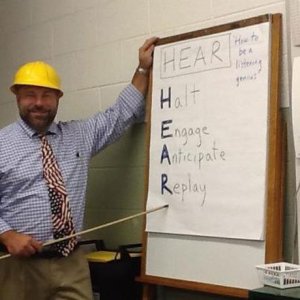Training the Brain to Listen: A Practical Strategy for Student Learning and Classroom Management
Your content has been saved!
Go to My Saved Content.During the school year, students are expected to listen to and absorb vast amounts of content. But how much time has been devoted to equipping students with ways to disconnect from their own internal dialogue (self-talk) and to focus their attention fully on academic content that is being presented? Listening is hard work even for adults. When students are unable to listen effectively, classroom management issues arise.
Explicit instruction on cognitive strategies that can help students learn how to learn may have a positive impact on both academic performance and classroom management by emphasizing that students are in charge of their own behavior and learning. Teachers we've worked with find that classroom management issues decrease over time as students begin to master thinking skills that help them become more self-directed learners.
Learning to listen well is a prime example of a skill that many assume shouldn't need to be taught. The Common Core State Standards for Language Arts recognize the importance of listening as an ability that students must master to become college and career ready:
From a developmental perspective, this Common Core standard is interwoven with the acquisition of verbal and social skills that are critical for students' success across many contexts. Listening is a crucial aspect of school and life, but it is often expected of students without ever being taught. As a former teacher, school psychologist and licensed counselor, Donna worked with many students whose learning challenges were rooted in an inability to listen effectively, and with couples and families in distress for the same reason.
The Anatomy and Psychology of Listening
A lesson on listening might begin with how the brain processes the sounds around us. We find that many students and teachers are fascinated by the inner workings of their brains. The process of receiving and decoding spoken words takes place in the auditory cortex, which is the part of the human brain's cerebral cortex that processes auditory input. The auditory cortex is located on both sides of the brain in the upper parts of the temporal lobes. Its job is to receive signals from the ears and to transmit those signals to other parts of the cerebral cortex for decoding sound into meaning. This system is instrumental in both profound and everyday aspects of hearing -- from the language development of infants to the appreciation of a stunning symphony.
The most common obstacle to effective listening is noise. The classroom can be a cacophony of teacher and students talking, chairs scraping across the floor, papers rustling, pencils dropping, doors opening and closing. While the brain's auditory system is capable of blocking out background noises to focus on specific stimuli, nonetheless all these sounds can be distracting.
"Noise" can also arise inside students' minds -- a persistent song stuck in one's head, pleasant daydreams, or unpleasant doubts about one's ability to understand a new concept or complete an assignment. The HEAR strategy described below is designed to help students recognize and block out that noise as they devote their attention to listening.
Teaching Students to Focus and Listen
Explicit instruction on using the HEAR strategy offers concrete steps to focus on and improve listening -- and emphasizes why and how developing this skill is so important. As Michigan teacher Aaron Rohde says, "Just saying that one is going to be a better listener is not enough to make it happen. One must work hard to improve such an essential skill."
The HEAR strategy consists of these four steps:
- Halt: Stop whatever else you are doing, end your internal dialogue on other thoughts, and free your mind to pay attention to the person speaking.
- Engage: Focus on the speaker. We suggest a physical component, such as turning your head slightly so that your right ear is toward the speaker as a reminder to be engaged solely in listening.
- Anticipate: By looking forward to what the speaker has to say, you are acknowledging that you will likely learn something new and interesting, which will enhance your attention.
- Replay: Think about what the speaker is saying. Analyze and paraphrase it in your mind or in discussion with the speaker and other classmates. Replaying the information will aid in understanding and remembering what you have learned.

Initially, teachers may need to lead several demonstrations of using the HEAR strategy and remind students when it is time to HEAR, but over time, listening should become more automatic. When Mr. Rohde taught this strategy to his third and fourth graders last fall, he wore a hardhat to emphasize that learning how to listen well is hard work. But he also tells his students, "Being a 'listening genius' will be beneficial in all areas of life -- in school, in personal relationships, and in professional work situations." We wholeheartedly agree!
A Few Words in Your Ear
We leave you with three questions.
- Is teaching cognitive strategies, like effective listening, part of your school's curriculum?
- What would happen to learning in your classroom if students became more effective listeners?
- How might you use (with modifications, if necessary) the HEAR strategy in your classroom?
